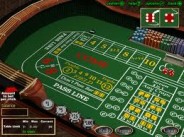
Golden Touch Dice Control Revolution! How to Win at Craps Using a Controlled Dice Throw!

Dice Control: Hardway versus V Sets
This article will be published in the new book by Sharpshooter and Jerry Patterson: Winning Dice Control Techniques – Shooting Craps from the Zone. To review more articles from this Chris Pawlicki (AKA Sharpshooter) has an engineering background which he has put to good use in his dice control research. He and Jerry Patterson created the "dice control revolution" with the development of the first dice control course in 1996. He published his own book, How to Control the Dice in 2002, and launched Sharpshootercraps.com in 2003. Chris's website is www.sharpshootercraps.com new book, visit Sharpshootercraps.com.
Chris Pawlicki (AKA Sharpshooter) has an engineering background which he has put to good use in his dice control research. He and Jerry Patterson created the "dice control revolution" with the development of the first dice control course in 1996. He published his own book, How to Control the Dice in 2002, and launched Sharpshootercraps.com in 2003. Chris's website is www.sharpshootercraps.com new book, visit Sharpshootercraps.com.
I have one very significant question which is not explained by your writing.
You say that the 'all hardway' is a beginners to intermediate set, and also that it does not create as many 7's as the 3-v.
However, the hardway set has 16 combinations (4 x 4) of 'on horizontal axis' faces, so.....if the dice transpose (don't pitch equally) it will yield four (4) 7's out of those 16 combinations, that is, 4/16, or 25% 7's.
The 3-v yields only two 7s out of those 16 combinations, that is, 2/16, or only 12 1/2% 7's.
So, even though your chart of rolls and yaws for the hardway set shows less 7's and less outside numbers than the 3-v, it appears to me that the 3-v is better if.....the dice stay on hozontal axis and don't roll or yaw at all.
Also, you say that you prefer to throw 3-v most of the time. I do too, and this is based on charting (recording every roll on a 3 x 5 card as i shoot.
So.....is 3-v best if and only if one can keep the rolling on axis, and if not, the hardway is best because overall it will throw less 7's?
You are correct in your interpretation. When I talk about successfully reducing 6 degrees of freedom (or ranges of motion) down to 3 in the dice delivery (a combination of vertical and horizontal translation with end-over-end rotation, or "pitching"), I'm talking about keeping the dice on a horizontal axis with no "roll" or "yaw."
Additionally and also very importantly, the dice must also be synchronized. That is, they must pitch, or rotate horizontally at the same rate and side by side. The right die should be the mirror image of the left die. This includes parallel trajectories, alignments and spin rates (they should be doing the same things at the same time). Under these ideal and well-practiced circumstances, you are indeed, better served using the 3-V (for inside numbers) or the 2-V (outside numbers) dice sets.
If the dice roll or yaw just one face off and you are using the 3 or 2-V sets, you may be staring at a seven-out! The Hardway set gives you 100% protection if you are only "one" face off in any rotational direction. You must be two faces off before you see sevens with the Hardway set.
Therefore, analyze your throw for that session, if the dice stay on axis, strike the table and maintain that axis before coming to rest, then you are better off with the V sets; any roll or yaw, and it now behooves you to switch over to the Hardway set for better all-round protection.
The 2-V Set is as powerful at avoiding the 7 as is the 3-V set (as far as different degrees of freedom are concerned), but the 3-V Set is more powerful at sniping out inside numbers (all primaries and several secondaries). These inside numbers have a higher frequency of occurrence and lower house edges than the outside numbers do. Those facts make the 3-V set (hands down) the most powerful set for someone who has mastered the Perfect Pitch Delivery System. I use the 3-V Set 80% of the time, the Hard Ways 10% and the 2-V Set 10% (sometimes when my point happens to a 4 or 10).
For a FREE Subscription to Sharpshooter’s Dice Control Newsletter containing morearticles from his new book, visit www.Sharpshootercraps.com

